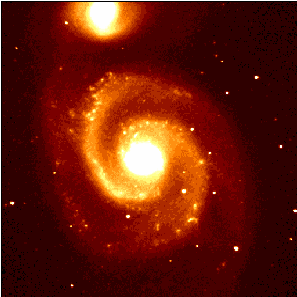
To make a rotation curve one calculates the rotational velocity of stars along the length of a galaxy by measuring their Doppler shifts, and then plots this quantity versus their respective distance away from the galactic center.
The galaxy "M51". Messier 51 is also known as NGC 5194 and sometimes called the Whirlpool galaxy. It is the prototypical "Grand Design" spiral (i.e. very symmetrical and regular arms). The galaxy is of type Sc and it is very nearly face-on. The distance to M51 is about 9 Mpc (or about 30 million light years), and it is moving away from us at about 500 km/s. The other object is the lenticular companion galaxy NGC 5195. This particular image was taken at near-infrared wavelengths. Picture provided by Rosa Gonzalez and Jim Graham.
Invariably, it is found that the stellar rotational velocity remains constant, or "flat", with increasing distance away from the galactic center. This result is highly counterintuitive since, based on Newton's law of gravity, the rotational velocity would steadily decrease for stars further away from the galactic center. Analogously, inner planets within the Solar System travel more quickly about the Sun than do the outer planets (e.g. the Earth travels around the sun at about 100,000 km/hr while Saturn, which is further out, travels at only one third this speed). One way to speed up the outer planets would be to add more mass to the solar system, between the planets. By the same argument the flat galactic rotation curves seem to suggest that each galaxy is surrounded by significant amounts of dark matter. It has been postulated,and generally accepted, that the dark matter would have to be located in a massive, roughly spherical halo enshrouding each galaxy.

The rotation curve for the galaxy NGC3198 from Begeman 1989
The first real surprise in the study of dark matter lay in the outermost parts of galaxies, known as galaxy halos. Here there is negligible luminosity, yet there are occasional orbiting gas clouds which allow one to measure rotation speeds and distances. The rotation speed is found not to decrease with increasing distance from the galactic center, implying that the mass distribution of the galaxy cannot be concentrated, like the light distribution. The mass must continue to increase: since the rotation speed satisfies v^2=GM/r, where M is the mass within radius r, we infer that M increases proportionally to r. This rise appears to stop at about 50kpc, where halos appear to be truncated. We infer that the mass-to-luminosity ratio of the galaxy, including its disk halo, is about 5 times larger than estimated for the luminous inner region, or equal to about 50. Many people believe that the galactic halos are composed of particle dark matter. The Center Direct Detection Group is actively searching for evidence of this dark matter.